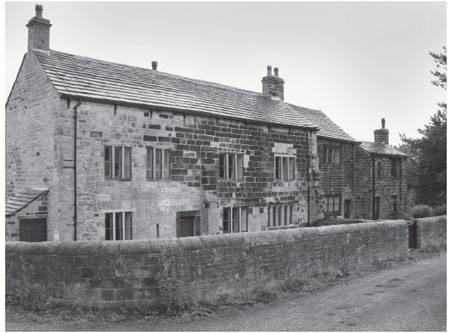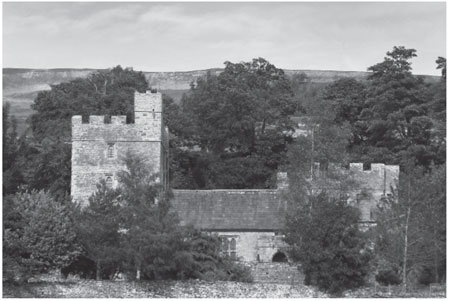Read Folklore of Yorkshire Online
Authors: Kai Roberts
Folklore of Yorkshire (22 page)

The earthworks at Skipsea Castle, haunted by a white lady. (Kai Roberts)
Sir Walter persisted in his refusal to cooperate and towards the end was said to have cried to a faithful servant who had remained by his side, ‘Them that love Sir Walter, pile on! pile on!’ His apparition is said to have endlessly repeated those words as he wandered the lane which runs to Calverly Hall. Alternatively, his ghost rode a headless steed and took great delight in hunting down unwary travellers, until he became such a menace that the local community had him exorcised. Meanwhile, inside the hall, a permanent bloodstain is supposed to discolour the woodwork in the chamber where the murder was committed, a stain which no amount of scrubbing can remove – another common motif in ghost lore of this kind.
Sometimes the sin need not be as mortal as murder. The man who built Swinsty Hall in Washburndale made his fortune by looting the houses of dead men in London during the Great Plague of 1665, and locals believed his apparition could be seen obsessively washing coins in the Greenwell at Timble in an attempt to disinfect them. The headless ghost of Sir Josceline Percy was believed to drive four headless horses around the streets of Beverley night after night, for the crime of once entering Beverley Minster on horseback. Even mere eccentricity became enough to justify supernatural immortality. As the folklorist Christina Hole notes, it reflected ‘the popular inability to believe that so strong a personality could really have suffered the common fate of death.’

Calverley Hall in West Yorkshire, where the ghost of murderous Sir Walter still walks. (Kai Roberts)
It was not just the sinners who were thought to return: often the sinned against suffered a similar fate in death and as we have seen with headless ghosts and white ladies, such was the connection in the popular mind between tragedy and subsequent hauntings that all manner of apocryphal traditions were devised to account for a phantom’s appearance, or they were often conflated with other popular local legends. For instance, the White Lady of Skipsea Castle is frequently said to embody the wife of the castle’s builder, Drogo de Bevere, who fought at the Battle of Hastings with William the Conqueror. For his loyalty he was gifted the lands of Holderness, along with the hand of William’s niece in marriage. However, their match was not successful and Drogo is said to have poisoned the unfortunate girl before fleeing back to Normandy.
Arguing against the genuine identification of the White Lady of Skipsea Castle as the unfortunate Lady de Bevere is the suspicion that the tradition of her murder is apocryphal and may be entirely fictitious. This is compounded by the curious but undeniable fact that historical phantoms were never seen until the late seventeenth century, and then did not appear in any great number until the nineteenth. The ghosts of the medieval and early modern period are always those of the recently dead; spirits from the distant past are not recorded until the advent of compulsory education and particularly the teaching of history. This may explain why ghosts are so associated with major conflicts which left a deep scar on the psyche of the region – or more prosaically, were well known from the history books.
In Yorkshire, this invariably means the Reformation or the English Civil Wars. A phantom known as the White Lass of North Kilvington once haunted Borrowby Bridge over the Spittlebeck, and was identified with the daughter of the Meynells. Tradition asserted that the girl had been raped and murdered by Henry VIII’s commissioners, when her staunchly Catholic family had refused to cooperate with the confiscation of monastic assets. Meanwhile, the headless woman that haunts a bedchamber at Watton Abbey is supposed to be the ghost of a former Royalist owner, murdered in that room by Roundhead irregulars as they looted the area following the Parliamentarian victory at Marston Moor. The story claims they beheaded her, but we have already seen how deceptive that motif can be.
Similarly, there is perhaps no reason beyond the romanticising power of tradition why the ghostly ladies believed to haunt Nappa Hall in Wensleydale and Manor Lodge in Sheffield should be identified with Mary, Queen of Scots. The unfortunate cousin of Elizabeth I passed only two nights at Nappa Hall as a guest of the Metcalfe family, whilst she was imprisoned at nearby Castle Bolton between July 1568 and January 1569. Although a maid some two centuries later claimed to have seen a spectre answering Mary’s description at Nappa Hall, she was not executed until 1587 at Fotheringay Castle in Northamptonshire and there seems little reason why her ghost should return to that hall in particular. Equally, she only spent brief periods at Manor Lodge between 1570 and 1584, whilst moving between various properties as a prisoner of the Earl of Shrewsbury. Still, her ghost is rumoured to haunt the roof of the Turret House – the only surviving part of the building.

Nappa Hall in Wensleydale, haunted by the ghost of Mary Queen of Scots? (Kai Roberts)
The connection between unnatural, tragic death and hauntings was so firmly established in the collective psyche that Mary was an inevitable candidate for post-mortem return, no matter how tenuous her connection with a property might have been. However, it was not just unnatural death which guaranteed such a fate: improper burial had similar consequences. These traditions doubtless had the dual effect of attributing a comprehensible cause to uncanny phenomena and reinforcing social taboos in eighteenth-century England. As criminals and suicides were those most commonly denied Christian burial, the implication was that such acts would result in a fate worse than mere physical death, as their souls would be refused access to Heaven and forced to wander the earth disconsolately until the Day of Judgement.
Belief that the spirits of suicides would walk after death was so ingrained in early modern society, that the corpses of individuals who had taken their own life were often pinned down in their graves and buried at crossroads to confuse their risen souls. An eighteenth-century Calderdale tradition held that following the suicide of Miller Lee of Mayroyd Mill in Hebden Bridge, his body was interred without ceremony at Four Lane Ends on the edge of Midgley Moor. However, his restless spirit proved such a menace to travellers passing by the crossroads, that his corpse was exhumed and reburied in a prehistoric cairn located on a more remote part of the moor, where his spectre could wander without causing disruption. Local folklore asserts that this Bronze-Age burial mound has been known as Miller’s Grave ever since.

Miller’s Grave in Calderdale, a prehistoric tumulus haunted by a suicide. (Kai Roberts)

The Busby Stoop near Thirsk, haunted by a gibbeted highwayman. (Kai Roberts)
The association between criminals and unhallowed burial did not have quite the same antiquity as suicides, and seems to be a very characteristic product of the eighteenth century. Although the use of gibbeting of a criminal’s corpse after execution had been used informally since the previous century, it did not become common practice until it was officially authorised by an Act of Parliament in 1751, and remained widespread until it was outlawed in 1832. As the criminal’s body was left to rot where it hung, in rural areas gibbets were often sited at crossroads to prevent their ghosts from walking and such traditions lingered long after the practice was discontinued. A pub known as the Busby Stoop, near Thirsk, was built on the former site of a gibbet, and it is still believed to be haunted by the restless spirit of Thomas Busby, a highwayman who was once gibbeted there. On bright moonlit nights, it is said that he can be seen leering from the window of the hostelry.
Of course, the innocent sometimes also suffered the ignominy of unconsecrated burial. Knaresborough vicarage was wracked by the sound of sobbing and icy gusts of wind through the corridors, until renovations uncovered human bones concealed beneath the floorboards. The remains were reinterred in consecrated ground and the trouble ceased. Likewise, a cottage at Barmby Moor occupied by two antiquaries was disturbed by untraceable footsteps and doors opening of their own accord – phenomena quickly attributed to a human skull the scholars had found in the churchyard. The relic had apparently been unearthed and cast aside by a gravedigger, so the pair had taken it for their private museum. Once reburied, the peace of their cottage was restored.
Battlefields also represented prime locations for spectral return. Not only were they the scenes of many tragic deaths, but often following the combat, the slain were left to rot on the ground or else deposited in unconsecrated mass graves. The Battle of Marston Moor, fought between the Royalists and Parliamentarians on 2 July 1644 during the English Civil Wars, was one of the largest conflicts ever enacted on British soil, in which over 4,000 soldiers were killed. The site of the confrontation is also one of the first recorded instances of a battlefield ghost: a headless cavalry officer covered in blood, who is said to ride frantically back and forth, searching for the action. The apparition was most commonly seen around Moor Lane, where some of the fiercest fighting took place and where a monument to those killed now stands.

